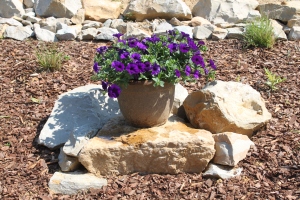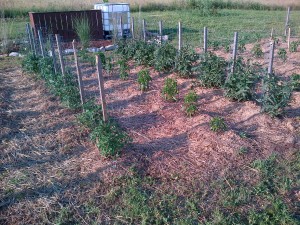So once that garden is all planted – there are some simple things you can do to really help maximize the growth and yields of your vegetable plants.
So here are our 3 tips to growing a better garden once you’ve planted:

One of the reasons container gardening works so well – is the soil never gets trampled or compressed by heavy feet walking around them – the same can go for your garden
1. STAY OFF YOUR PLANTS
Whether you have raised beds, raised rows, regular rows, or just a few simple garden plants tucked in to your flowerbed or small space – don’t walk near them. When you compact the area around a plant with big soil clogging foot prints and heavy foot traffic – it really does make it harder for the plant to grow bigger roots. Less roots = less ways for the plant to soak up the valuable water and nutrients from the soil that benefit the plant. If you leave the area around a plant undisturbed and uncompacted – it makes for much healthier plants. It’s one reason raised beds and container gardens can be so effective – but even if you don’t have them – you can make a huge difference just by staying off the ground around your plants.

Mulching your garden plants is a great way to regulate soil temperature – suppress weeds, and hold in moisture for the plants.
2. MULCH YOUR PLANTS
It doesn’t matter if it’s a pepper, cucumber, or tomato plant. Applying a healthy amount of mulch around the base of the plant really helps. It helps the plant retain valuable moisture. It helps the soil temperature around the plant stay more regulated, and helps keep out weeds that compete for nutrients. It also helps hold in the water to the plants when it rains. What to use as a mulch? Old grass clippings, finished compost or straw work great.
3. WATER SMART
This may be the best advice of all. Just remember 3 things when it comes to watering that make it simple. WHEN, HOW and HOW MUCH.
WHEN:
Watering in the early morning is best. Before the sun has a chance to really get hot. Water at the base of the plants and let it soak in. If you water in the afternoon – you not only run the risk of burning the leaves from the sun scorching the water that may hit the plant – but you lose a lot more to evaporation than watering in the early morning. Besides your beer or favorite beverage gets so much warmer in the hot sun 🙂
HOW:
Water slowly and at the base of each plant. Let it soak in and come back a few times and apply smaller amounts that soak right in where it’s needed most at the root level of the plant Spraying the whole garden with a big hose and spray nozzle can lead to a lot of problems besides just scorching plants – like damaging plants, or destroying the blooms that create the vegetables by too hard of a spray, or helping fungus and rot develop on wet moist leaves.
HOW MUCH
Too little water and they shrivel up. Too much water and they won’t develop the good and deep root structure needed for big plants. A good rule of thumb is that a garden plant typically needs to receive about 1 inch of water a week. If mother nature isn’t supplying that – then you need to supplement. What most don’t say is that the 1″ of water shouldn’t come all at once. If you are experiencing a prolonged dry spell – water every two to three days with about a 1/2″ of water to the plant at a time. This allows enough water to go deeper into the soil and build deeper roots – but gives the plants more consistent watering. Why not every day you might ask? If you water every day – the plants will never send their roots deeper looking for water – and you end up with much less hardy and developed plants. Call it tough love watering to develop stronger plants – but it works.
Happy Gardening!!! – Mary and Jim
If you would like to receive our weekly DIY and Gardening Posts – be sure to sign up to follow our blog via email, Twitter or Facebook in the right hand column of the blog.



